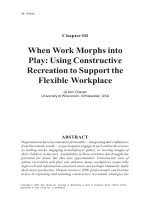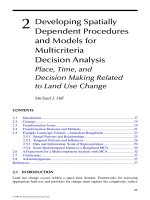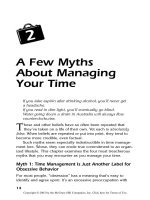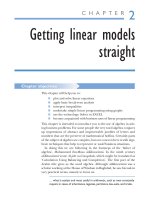New Products Management - CHAPTER 2 doc
Bạn đang xem bản rút gọn của tài liệu. Xem và tải ngay bản đầy đủ của tài liệu tại đây (502.42 KB, 19 trang )
PART TWO
PART TWO
CONCEPT GENERATION
CONCEPT GENERATION
McGraw-Hill/Irwin
Copyright ©2006 The McGraw-Hill Companies, Inc. All right reserved.
Concept Generation
Concept Generation
Figure II.1
CHAPTER 4
CHAPTER 4
PREPARATION AND ALTERNATIVES
PREPARATION AND ALTERNATIVES
McGraw-Hill/Irwin
Copyright ©2006 The McGraw-Hill Companies, Inc. All right reserved.
Genius Thinking Strategies
Genius Thinking Strategies
Geniuses find many different ways to look at a problem.
Einstein, for example, and da Vinci, were
well known for looking at their problems from many different perspectives.
Geniuses make their thoughts visible.
Da Vinci’s famous sketches, and Galileo’s diagrams of the
planets, allowed them to display information visibly rather than relying strictly on mathematical
analysis.
Geniuses produce.
Thomas Edison had a quota of one invention every ten days. Mozart was
among the most prolific composers over his short life.
Geniuses make novel combinations.
Einstein found the relationship between energy, mass, and
the speed of light (the equation E=mc²).
Geniuses force relationships.
They can make connections where others cannot. Kekule dreamed
of a snake biting its tail, immediately suggesting to him that the shape of the molecule he was
studying (benzene) was circular.
Geniuses think in opposites.
This will often suggest a new point of view. Physicist Neils Bohr
conceived of light as being both a wave and a particle.
Geniuses think metaphorically.
Bell thought of a membrane moving steel, and its similarity to the
construction of the ear; this led to the development of the telephone earpiece.
Geniuses prepare themselves for chance.
Fleming was not the first to see mold forming on a
culture, but was the first to investigate the mold, which eventually led to the discovery of penicillin.
Source: Michael Michalko, “Thinking Like a Genius,”
The Futurist
, May 1998, pp. 21-25.
Figure 4.1
“
“
Killer Phrases:”
Killer Phrases:”
Roadblocks to Creativity
Roadblocks to Creativity
It simply won’t work.
Are you sure of that?
You can’t be serious.
It’s against our policy.
Let’s shelve it for the time
being.
That won’t work in our
market.
Let’s think about that
some more.
I agree, but…
We’ve done it the other
way for some time.
Where are you going to
get the money for that?
We just can’t do that.
Who thought of that?
It’s probably too big for us.
I believe we tried that
once before.
Figure 4.3
Historic Roadblocks to Creativity
Historic Roadblocks to Creativity
“I think there is a world market for maybe five computers.”
Thomas Watson, Chair, IBM, 1943.
“Computers in the future may weigh no more than 1.5
tons.”
Popular Mechanics, 1949.
“I can assure you that data processing is a fad that won’t
last out the year.”
Business books editor, Prentice-Hall, 1957.
“So we went to Atari and said, ’We’ll give it to you. We
just want to do it. Pay our salary, we’ll come work for you.’
And they said no. So then we went to HP, and they said
‘We don’t need you, you haven’t got through college yet.’”
Steve Jobs, co-founder, Apple Computers.
“640K of RAM ought to be enough for anybody.”
Bill Gates,
Microsoft, 1981.
Historic Roadblocks to Creativity
Historic Roadblocks to Creativity
“Who the hell wants to hear actors talk?”
H.M. Warner, Warner
Bros., 1927.
“Stocks have reached what look to be a permanently high
plateau.”
I. Fisher, Prof. of Economics, Yale, 1929.
“We don’t like their sound, and guitar music is on the way out.”
Dick Rowe, Decca Records executive, rejecting the Beatles’ demo
tape, 1962.
“This ‘telephone’ has too many shortcomings to be seriously
considered as a means of communication [and] is inherently of
no value to us.”
Western Union, 1876.
“Heavier-than’air flying machines are impossible.”
Lord Kelvin,
President, Royal Society, 1895.
“Everything that can be invented has been invented.”
C. H. Duell,
Commissioner, U.S. Office of Patents, 1899.
Barriers to Firm Creativity
Barriers to Firm Creativity
Cross-functional diversity:
Diversity leads to more
creative stimulation but also to problem solving
difficulties.
Allegiance to functional areas:
Team members need to
have a stake in the team’s success, or won’t be loyal to
the team.
Social cohesion:
If interpersonal ties among team
members are too strong, candid debate may not occur,
resulting in less innovative ideas.
Role of top management:
Management should
encourage the teams to be adventurous, otherwise only
incremental changes will occur.
Figure 4.4
Required Inputs to the Creation
Required Inputs to the Creation
Process
Process
Form
(the physical thing created, or, for a
service, the set of steps by which the service
will be created)
Technology
(the source by which the form is
to be attained)
Benefit/Need
(benefit to the customer for
which the customer sees a need or desire)
Technology
permits us to develop a
form
that
provides the
benefit
.
Some Patterns in Concept Generation
Some Patterns in Concept Generation
Customer need firm develops technology
produces form
Firm develops technology finds match to need in a
customer segment produces form
Firm envisions form develops technology to
product form tests with customer to see what
benefits are delivered
Note: the innovation process can start with any of the
three inputs.
What is a Product Concept?
What is a Product Concept?
A product concept is a verbal or prototype
statement of what is going to be changed
and
how the customer stands to gain or lose.
Rule: You need
at least two
of the three inputs
to have a feasible new product concept, and
all
three
to have a new product.
Why Do You Need a Product Concept
Why Do You Need a Product Concept
and Not Just an Idea?
and Not Just an Idea?
Needed to judge whether it is worthy of
development
Potential customers do not have enough
information to judge the worthiness of an idea:
the product concept gives them the required
information.
Ex.: Would a taxi operator like cars with a 10
cents per mile operating cost? (need)
Not if it used Caterpillar tractor technology instead of
wheels! (need plus technology)
New Product Concepts and the
New Product Concepts and the
New Product
New Product
Need
Need
Form
Form
Technology
Technology
New
Product
“C”=
Concepts
C
C
C
C
C
C
Figure 4.4
The Designer Decaf Example
The Designer Decaf Example
Benefit:
“Consumers want decaffeinated
espresso that tastes identical to regular.”
Form:
“We should make a darker, thicker,
Turkish-coffee-like espresso.”
Technology:
“There’s a new chemical extraction
process that isolates and separates chemicals
from foods; maybe we can use that for
decaffeinating espresso coffee.”
Why would each of these taken individually not
be a product concept?
What a Concept Is and Is Not
What a Concept Is and Is Not
“Learning needs of computer users can be met by using
online systems to let them see training videos on the
leading software packages.” (good concept; need and
technology clear)
“A new way to solve the in-home training/educational
needs of PC users.” (need only; actually more like a wish)
“Let’s develop a new line of instructional videos.”
(technology only, lacking market need and form)
Methods for Generating Product
Methods for Generating Product
Concepts
Concepts
Two Broad Categories of Methods:
Gathering Ready-Made Product Concepts
Using a Managed Process Run by the New
Products Team
Best Sources of Ready-Made New
Best Sources of Ready-Made New
Product Concepts
Product Concepts
New Products Employees
Technical: R&D, engineering, design
Marketing and manufacturing
End Users
Lead Users
Resellers, Suppliers, Vendors
Competitors
The Invention Industry (investors, etc.)
Idea exploration firms and consulting engineers
Miscellaneous (continued)
Figure 4.6
Best Sources of Ready-Made New Product
Best Sources of Ready-Made New Product
Concepts (continued)
Concepts (continued)
Miscellaneous Categories
Consultants
Advertising agencies
Marketing research firms
Retired product specialists
Industrial designers
Other manufacturers
Universities
Research laboratories
Governments
Printed sources
International
Internet
Figure 4.6
Lead Users
Lead Users
An important source of new product ideas.
Customers associated with a significant current
trend.
They have the best understanding of the
problems faced, and can gain from solutions to
these problems.
In many cases, have already begun to solve
their own problems, or can work with product
developers to anticipate the next problem in the
future.









